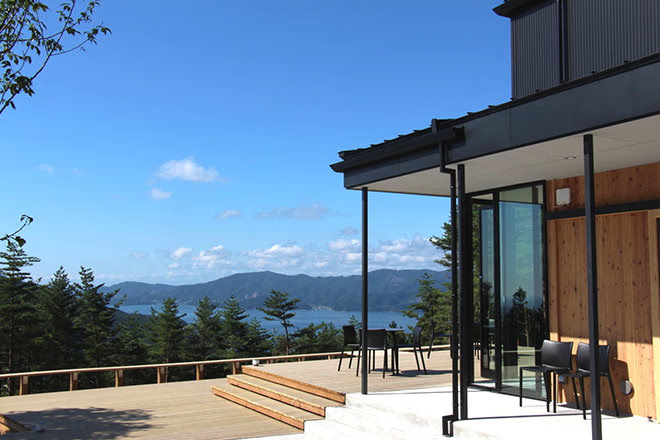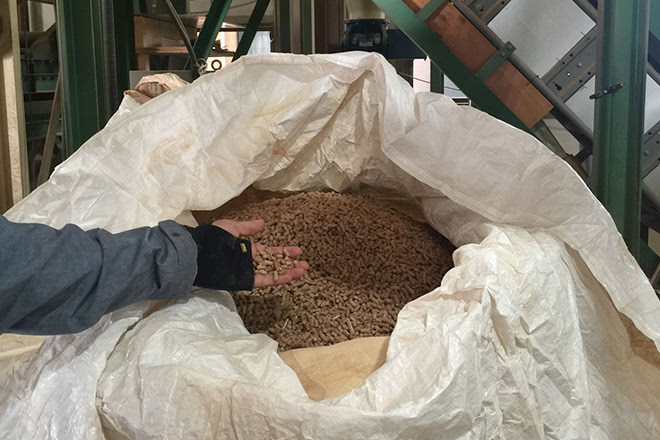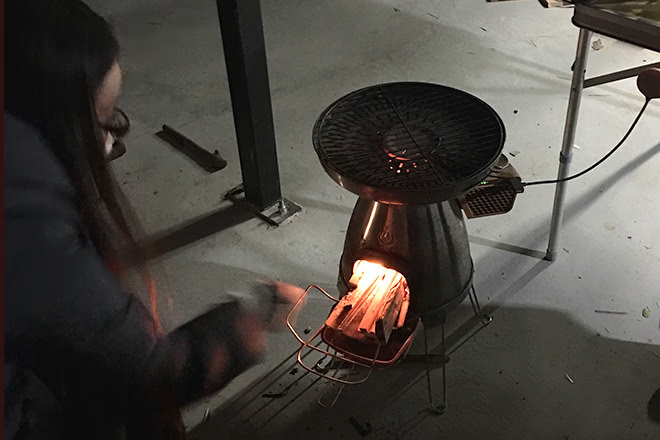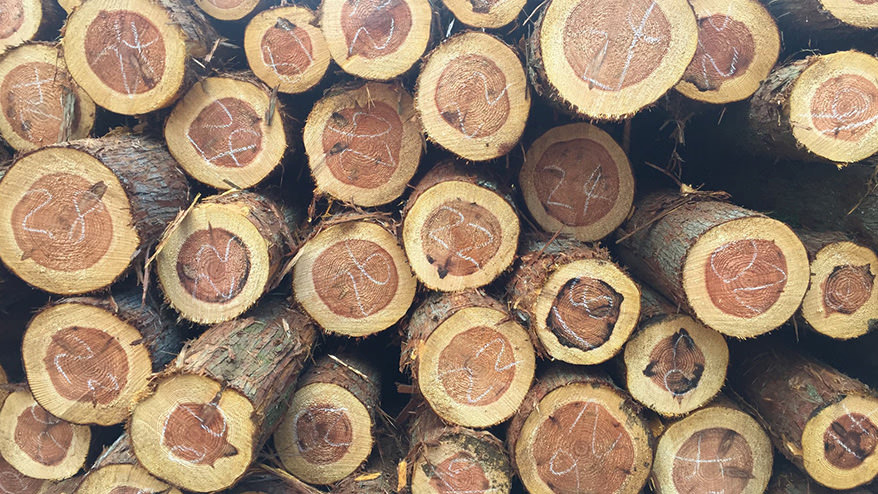プロデュース部の上村です。私たちプロデュース部が関わっているプロジェクト『Google イノベーション東北』では、東北復興を更に加速することを目指して、地域活性に取組む先進的なさまざまな地域のプレイヤーたちをサポートしています。2015年、このプロジェクトからひとつのイベントが誕生しました。
イベントの生みの親は、岩手県陸前高田市・箱根山テラスの長谷川順一さんと、岡山県西粟倉村・あわくら温泉元湯の井筒耕平さん。それぞれの地域で、それぞれの地域の特性に合わせた木質バイオマスの普及に取り組むフロントランナーです。イノベーション東北を通じて出会った2人が、「地域にちょうどいいエネルギーを食事会のようなノリで語り合おう!」と意気投合。『木質バイオマスとおいしいご飯の集い』というコンセプトの「WoodLuck」というイベントが生まれました。
陸前高田市と西粟倉村、700km以上はなれた東と西の小さな場所に、人が集い、おいしいものを一緒に食べて、語りあう。そこから、大きなエネルギーの渦が日本中に広がりはじめています。
11月5〜7日に開催されたこのイベントの第1回に、バイオマスの「バ」の字も分からなかった私が参加することになり、3日間を過ごして何を感じたのか、率直にお伝えしようと思います。

第1回の会場ととなった、陸前高田にある宿泊施設、箱根山テラス。その名の通りの広いウッドテラスからは広田湾を一望できる。主催者・長谷川さんの木質バイオマスの拠点で、宿泊者が集うカフェ&バーには大きなペレットストーブがある。
「木質バイオマス」はるか遠く。
2泊3日のイベントは、初日にバイオマスの現場を視察し、2日目に視察の感想や自分たちの活動をプレゼンするワークショップ、最終日は3日間を振り返って終了というプログラム。
合間合間には大事な「おいしいご飯」が待っています。
私が最初にしたことは、恥ずかしながら「木質バイオマス」というキーワードで検索してみることでした。しかしいくら調べても出てくる結果は「森林資源」「カーボンニュートラル」「再生可能エネルギー」・・・東京で暮らす私にとっては遠い世界の言葉ばかり。
とはいえ、このまま手ぶらで行くわけにはいかないので、
- 木で作られた燃料を燃やして、熱や電気などのエネルギーを作り出すこと
- 木質バイオマスの燃料は、薪/ペレット/チップの3種類があること
という、本当に基本的なことだけを頭に入れて、”ひのきのぼう”と”ぬののふく”のような心もとない装備を携えてイベントに臨んだのでした。

これがペレットストーブ。煙はほとんど出ないため、都会の住宅でも導入可能。このストーブはペレットという木の粒が落ちるときの「カランカラン」という音が心地いい。
季節は秋、東京はようやくコートを引っ張り出し始めた頃、集合場所の一ノ関駅に降り立つと、もう東北は冬を感じさせる寒さ。参加者同士の挨拶もそこそこに、初日のバイオマス現場視察がスタートしました。
実際の順番とは前後しますが、山で杉の木を伐採し、製材するときに端材が出て、その端材がペレットになり、ボイラーやストーブで使われるまでの、上流(生産)から下流(消費)までひととおりを見学。
くさびとチェーンソーで伐採する様子に、ついつい映画『WOOD JOB!』を思い出してしまったり、できたての熱いペレットを触ったりと、参加者からの歓声が絶えない視察でした。
その中で私が最も印象深かったのは、伐採現場に向かう途中、ある山を通りかかった時のこと。
「あの暗い山をよく見て覚えておいて。木というのは切りすぎてもダメだけど、かといって切らなすぎても、成長するにつれ地面に日が当たらなくなって、木はどんどん痩せていくんだ。」
という主催の長谷川さんの言葉に、私はがつーんと衝撃を受けたのでした。
「木を大切にしましょう」と聞かされて育った私は、「木を大切にすること=木を切らないこと」だと思い込んでいました。しかし、手を入れないことで逆に木は痩せ、木材としての価値がなくなり、結局山は放置されてしまう・・・。
よくよく考えれば当たり前のことかもしれませんが、目の前にある真っ暗な、5m先も見えないような山を見ながらその話を聞いたことで、腹の底から実感できたのです。私はあの暗い山を一生忘れないだろうな、と思ったのでした。

伐採した木を掴んで、そのまま先についた刃で切り分けてしまうすごい機械。自分の手足のような器用な動きに、参加者は歓声を上げながら見守っていた。重機の先につけるこの高性能なアタッチメントは、重機本体と同じぐらい高価らしい。
地域の資源を、
地域で使うということ
今回視察した行程は、隣り合ったひとつの近い地域のなかで起こっていることです。
木を育てる→伐採する→木材を加工する→端材からペレットを作る→ストーブやボイラーの燃料としてベレットを使う。この「エネルギーの地産地消」こそが、木質バイオマスが実現する"地域にとっての大きな可能性"なのです。
ストーブやボイラーで多く使われる灯油(化石燃料)は、ほとんどを海外から購入しているため、消費すればするほど日本の外にお金が出ていきます。しかし、地域にもともとある資源をつかって地産地消のしくみを作ることで、燃料を購入する費用が地域内に支払われるだけでなく、燃料への加工、配送、販売といった新たな仕事が生まれ、雇用の増加にも繋がります。
これだけ森林資源に恵まれた国で、しかもある程度伐採されたほうが山は健康に保たれる。さらに木質エネルギーを地産地消することで、地域内に経済循環が起こり、新たな仕事までつくられる。・・・つまり、日本で木を使って地産地消のエネルギー循環をつくるという取り組みは非常に理にかなっているのです。

これが木質ペレット。猫飼いさんには、猫のトイレ砂としてお馴染みのあの木の粒。もともと「ごみ」として捨てられていたような木材や端材が使われている。その他にも、籾殻(もみがら)や廃菌床、鶏糞(!)など地域の特性に合わせて色々なペレットも開発されている。
視察を進めながら、最前線で取り組む方々にそんな話をたくさん聞いて、木質バイオマスと地域との関わり方を深く理解していくと同時に、経済合理性とかエネルギー自給率なんてひとまず脇に置いた、自分の心の奥の奥に、「いい!とにかく木質バイオマスってなんかすごくいい!」という、ドキドキするようなムズムズするような感情が湧き上がってきたのでした。
となりの「木質バイオマス」、
ジブンゴトになる。
そんなムズムズを胸に秘めたまま参加した、2日目のワークショップ。
8名の参加者が各自10分間、まずは自分という人間をプレゼンし、1日目の視察を通して感じたことを率直に語っていきます。
集まった参加者は様々。木質バイオマスの普及を10年以上やっている人もいれば、林業に携わる人、ペレットストーブを家に置いてみようかなと興味を持ち始めた人、そして私と同じように「バイオマスってなに?」という人もいて、話す内容も専門用語から初歩的な質問、自分が思ったままの感想まで、レベルはバラバラ。しかし、それこそがこのイベントの醍醐味なのです。
「WoodLuckをきっかけに、“普通の人”がバイオマスを語れるようになった。これは本当にすごいことで、バイオマス業界が次のステージに行ったなと感じる。」
イベントの生みの親の一人である井筒さんは、ワークショップを終えてそう語りました。
たとえ木質バイオマスのことをよく知らなくても、自分の体験と感情を元に、自分の言葉で語ることこそワークショップの一番の目的であり、最前線にいる人たちにとっては、それらの率直な意見や質問が「よりわかりやすく・正しく伝える」ヒントにもなります。
何度も休憩を挟みながら(しかし休憩時間もコーヒー片手にあちこちで話は続き)、ワークショップはなんと8時間にも及びました。
ワークショップを終えたあとの夜ご飯は、自家製ピザ窯(もちろん燃料は薪)を使って、全員でピザ作り。ワーワー言いながら生地をこねて、キャッキャと具を乗せ、共同作業で次々とピザを焼いて、たっぷり海の幸が乗ったパエリア、野菜がごろごろのポトフと一緒に、コンセプトどおりの『おいしいご飯』を楽しんだあとは、いつの間にやら WoodLuck 夜の部がスタートしていました。

このピザ窯は基礎からレンガ積みまで全て、主催者の長谷川さんたちの手作り。参加者にも大好評でピザは瞬く間に食べ尽くされた。自分たちの手でこねて、好みの具を乗せて、薪で焼いたピザは、ひときわおいしい。
不思議なもので、3日間同じ釜の飯を食い、同じ場所で寝泊まりしていると、なんとも言えない『仲間感』が生まれてきます。参加者たちは小さいグループをいくつも作りながら、まるで昔からの友人のように、木質バイオマスのことから自分の人生相談まで、ペレットストーブを囲みながら本音で語り合っていました。
かと思うと、火を囲みながら黙々とお酒を飲み、しっとり静かな時間を共有しているグループもいて、私自身は後者のグループと一緒に、ほぼ言葉を発することなく気づけば5時間、ひたすら薪を焚べ続けていました。
「火を前にすると人間は正直になる」と誰かが言っていた通り、薪を絶やさないこと、灰を掻くことだけに気を配って、頭の中身も心の中身も全部さらけだして再整理して、新しく出会った価値観と、そして自分自身の暮らしと自分の周りの環境をひたすら見つめなおす、人生で一番濃密な夜となりました。
3日間を通じて
自分の中に残ったものはなんだったのか。
私がこのイベントを通して得たものは、今起こっていることを自分の目で見て、ペレットストーブの暖かさを自分の肌で感じて、ペレットが落ちる心地よい音を自分の耳で聞いて、そして何より自分の手で薪を焚べ続けて自分と向き合う時間を持ったという、人生の中でこの上ない「体験」でした。
この体験によって、自分でも驚くほどの勢いで「木質バイオマス」というものに興味を持ちはじめ、イベントから3ヶ月以上たってもその熱が冷める気配がありません。
自分の知らなかった世界が急に実感を持って襲ってきて、私の中の価値観ががらっと変わっていく、あの扉の開くようなわーっという感覚を、今もうまく言葉にすることができないでいます。

黙々と薪を焚べ続ける私を隠し撮りされた写真。何かを焼くわけでもなく、ただ薪を焚べて、灰を掻き出し、ひたすら考え事をするだけで5時間経っていた。こんなに長い時間PCやスマホに触らなかったのは何年ぶりだろう。
実はこの記事を書くにあたっても、何度もなんども書き直しを繰り返し(編集長ごめんなさい)、そのたびに切り口や伝えたいことが変わっていったのは、今も私があの3日間の体験を自分の中で消化し続けている最中だからなのだと思います。
先日、岡山県西粟倉村でもう一人の生みの親・井筒さんが開催したWoodLuck #2にも参加してきました。西粟倉村ならではの間伐の現場を視察したり、朝6時に起きて薪ボイラーの着火を見学したり、薪で炊いたごはんを食べたり。「薪とともに暮らすライフスタイル」を体験することで、ペレットとはまた違う薪の良さ・面倒くささ、そして地域の暮らしに根ざした木質バイオマスの実現を、新たに感じることができました。
次回、WoodLuck #3は新潟市秋葉区で開催予定。きっと100の地域があれば100通り、その地域ならではの木質バイオマスのやり方を見ることができるのだと思います。
火を囲んで団欒する、寒い日に体を温める、火を前にして無心になる。
化石燃料への依存とか二酸化炭素排出量の削減とか、世界規模の難しいエネルギー問題ではなく、ただただ自分のまわり半径5mから、心地いいと思うエネルギーを考える。そんなイベントがこれから日本全国に広がっていき、参加した人にとって思わず「ジブンゴト」になってしまうような体験が生まれ続けていく、そう思うと心の底からワクワクします。
そんなワクワクに出会ってしまった私が、これから先、バイオマスを普及していく立場になるのか、家にペレットストーブを入れて楽しむ消費者の立場になるのか、はたまた普及活動をサポートしていく立場になるのかは、まだわかりません。ただただ「もっと知りたい」という自分の気持ちに正直に、知りたいことを知り、見たいものを見て、体験したいことを体験して、私なりの関わり方を探っていこうと思う2016年です。

